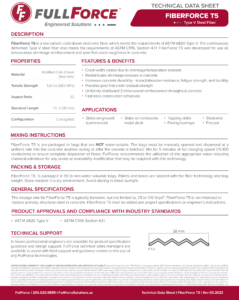FiberForce T5
General Information
FiberForce T5 is a modified cold-drawn steel wire fiber, which meets the requirements of ASTM A820 Type V. The continuously
deformed Type V steel fiber also meets the requirements of ASTM C1116, Section 4.1.1.
Additional Information
BATCHING
Truck Mixed (Dry Batched) Concrete
- Portable Conveyor Loading: Adding steel fibers to the mix can be labor intensive. To ease the addition of steel fibers, FiberForce has a fleet of portable conveyors available. Please note that FiberForce [T1-60, T5] is NOT packaged in degradable bags/boxes. The fibers should be distributed uniformly on a conveyor belt. The belt then introduces them to the mixing drum continuously while it is rotating at mixing speed. Ensure proper personal protective equipment such as gloves and eye protection are used when batching steel fiber reinforced concrete and be sure to consult with your safety supervisor to ensure this technique is within the guidelines of safe operating practices.
- Post-loading (Tail Loading): FiberForce [T1-60, T5] steel fibers can be staged at the slump rack or on temporary scaffolding and added after all the standard ingredients have been thoroughly mixed with the drum revolving at mixing speed. They should be added in a continuous manner while the drum is revolving at mixing speed to ensure optimal distribution.
- Preloading: It is NOT typically recommended to preload steel fibers because preloading can lead to balling of the fibers. If preloading is to be considered, strict attention from ready-mix truck drivers needs to be exercised, and we encourage pre-pour meetings.
Central Mixed (Wet Batched) Concrete
- Loading: It is typically recommended to post-load the fibers after the concrete has been discharged into the truck because typical central-mix plant configurations will limit the opportunity to add the fibers directly to the central mix drum. Please refer to dry batch concrete loading options above. If there is an opportunity to add fibers into the central mix drum, please consult with your FiberForce Technical Sales Manager for the best mixing procedures for your project or to discuss portable conveyor options.
MIXING
When fibers are added directly to the truck (either preloading or post-loading), mix for 5 minutes at full charging speed (75-100 revolutions) to ensure complete, uniform fiber dispersion. Slower agitation speeds during transport to the site are insufficient for proper fiber dispersion and should not be counted toward the fiber mixing time.
If fibers are added to central-mix drum, please discuss the appropriate mixing cycle length with your FiberForce Technical Sales Manager.
Check each truck for full dispersion of fibers prior to placement. If it appears that the fibers are balling, additional mixing at charge speed can help break up fiber balls.
Common causes of fiber balling:
- Truck drums with significantly worn-down blades have been used.
- Loose fibers can get hung up on rough loading chute of a truck mixer.
- The mixture is harsh with a high volume of coarse aggregate (more than 55% of the total combined aggregate by absolute volume) and not enough mortar.
- High volume percentages of steel fibers (>0.33%) by volume have been used without compensating for the increased paste demand. FiberForce recommends the use of pre-construction trial mixes and the addition of a mid- to high-range water reducing admixture. Additional water should not be added as this could adversely affect the hardened concrete properties. For more information on adjusting the mix design of FRC, please see the Technical Bulletin titled “Mixture Proportioning for FRC.”
Get in touch
Physical address
Helena Industrial Park
545 Elm Street
Helena, AL 35080
Mailing address
P.O. Box 580
Helena, AL 35080
Send a message



